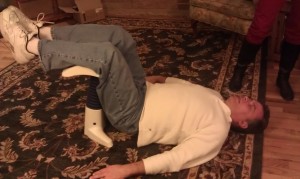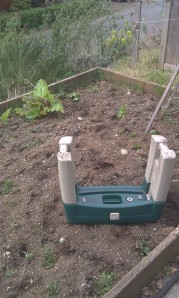Do I need a pain diagnosis?
I was standing in front of the piano along with my fellow choir members. Heading back to my seat, I realized my right leg was dangling from my hip. No feeling. Just a dead weight. While standing for rehearsal something, probably in my back, pinched off a nerve to the entire leg. Numb. If I took a step, would I crash to the ground?
This has happened before. I was alarmed by the numbness in late May of 2013. I was leaving in a few days for a writers’ retreat in southern France. While I have experience the numbness off and on during the past two and a half years, when it came on right before leaving for a 100-mile hike in England in May of 2014, I was worried. I remembered walking from Montmartre to the Shakespeare and Company bookstore on the left bank, talking to my right leg the whole way, “Lift, swing, step, lift, swing, step.”
The incident last week was much worse.
Dr. Kirdahy, the chiropractor who has been keeping me out of the operating room for years, was puzzled when I went to see him. “You have no pain?” “No” I reassured him. “I have no pain.” “How can that be?”
Maybe because I take Shaklee’s Pain Relief Complex first thing in the morning and as often as required to keep pain at bay all day long.
“What’s in this Pain Relief?”
Pain Relief contains two herbs: Boswellia and Safflower
Boswellia extract
- A controlled clinical trial found that a daily dosage of 1,000 mg of Boswellia
Extract taken in divided doses significantly improved joint discomfort,
Knee flexion, and walking distance.1
- In a clinical study, an extract containing boswellic acids was shown to promote
comfortable joint movement.2
Safflower extract
- The benefits of the safflower are newly discovered in the West, but have a long
tradition of use in Asia.3
- Kimmatkar et al. Efficacy and tolerability of Boswellia serrata extract in treatment of osteoarthritis of knee: a
randomized double blind placebo controlled trial. Phytomedicine. 2003;10:3–7.
- Etzel R. Special extract of Boswellia serrata (H15) in the treatment of rheumatoid arthritis. Phytomedicine.
1996;3:91–94.
- Hsu HY. Oriental Materia Medica. A Concise Guide. 1986. New Canaan, CT, Keats Publishing Inc. and
Oriental Healing Arts Institute, Long Beach, CA.
[From the Shaklee Product Guide, a fact sheet]
I told Dr. Kirdahy I would come back next week after 36 hours without any Pain Relief Complex.
This chiropractic visit induced a search of the literature for the answer to my question: does pain help diagnosis?
According to Spine Health, because the causes of back pain can be very complex, it is often more difficult to get an accurate diagnosis for back pain than for other medical conditions. While some spinal diagnoses are relatively straightforward (such as tumors, infections, or fractures), for many conditions there is little agreement among spine specialists about a diagnosis.
However, getting an accurate diagnosis of the cause of back pain is critical, because different diagnoses will require very different treatment approaches. And the sooner an accurate diagnosis is made, the sooner the patient can find an appropriate treatment for pain relief and to improve his or her ability to enjoy everyday activities.
Pain is our friendliest enemy — it keeps us out of trouble even though it often seems to actually be the problem.
The body ‘locates’ pain near the surface quite well but has trouble indicating the source when the pain is deep. Pain from deep injuries, diseases or infections of organs, such as the heart, stomach, lungs and back may seem to come from somewhere else nearby or may radiate into multiple places. Intense pain may be more localizing but not always.
Therefore, when back pain is accompanied with other changes, fever, swelling, redness, heat, neurological problems or changes in body functions, the diagnosis may be sharper — and the back pain diagnosis may be more serious.
The milder backaches that one feels over one’s lifetime can generally be successfully managed by simple back pain treatments — rest, medication, massage, the application of salves, exercise, weight loss and learning to put up with it.
So, if the severity of back pain does not serve as a guide for when to see a physician, the question is how does one know? While there are exceptions, there are several generally accepted guidelines of when to see a doctor for back pain:
If the back pain has any of the following characteristics, it is a good idea to see a physician for an evaluation:
- Back pain that follows a trauma, such as a car accident or fall off a ladder
- The pain is constant and getting worse
- Back pain that continues for more than four to six weeks
- The pain is severe and does not improve after a day or two of typical remedies, such as rest, ice and common pain relievers (such as ibuprofen or Tylenol)
- The pain is worse at night (most common forms of back pain are alleviated by rest)
- Severe pain at night (e.g. pain that wakes one up from deep sleep)
- Abdominal pain that accompanies the back pain
- Numbness or altered sensation in the saddle area (upper inner thighs, groin area, buttock or genital area)
- Neurological problems, such as weakness, numbness or tingling in the leg(s) or arm(s).
I have seen orthopedists, neurologists and sports medicine doctors for my chronic pain. Currently, I handle the pain 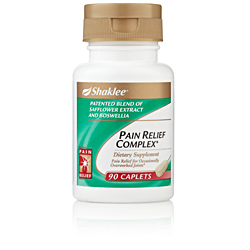 with Pain Relief Complex, exercise, Back2Life machine every morning, and moving as much as possible during the day (sometimes a challenge as I am a writer!) So I would say I live my life pain free.
with Pain Relief Complex, exercise, Back2Life machine every morning, and moving as much as possible during the day (sometimes a challenge as I am a writer!) So I would say I live my life pain free.
The above article persuades me that it is time to cut out the Pain Relief for a day or two to see just how bad this pain is. Before leaving for England last May, I had an MRI and a consultation with the Sports medicine doctor at my clinic. She told me I have several bulging discs, a normal condition in people my age, but that I was not at risk for hospitalization or major trauma on my hike. In fact, she assured me, the 100 miles hike would be good for me.
And it was.
The degree of increase in the numbness worries me. Doing without Pain Relief even for 48 hours worries me, too.
I’ll keep you posted. Next week, I will discuss the most common medications used to handle osteoarthritis pain, and why you might want to think twice about using them habitually. Stay tuned.
Be well, Do well and Keep moving,
Betsy
206 933 1889
Leave your comments. They help other readers and me, too.

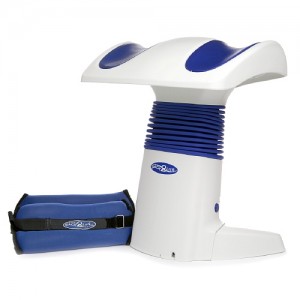


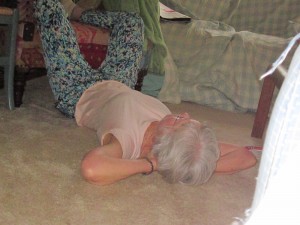
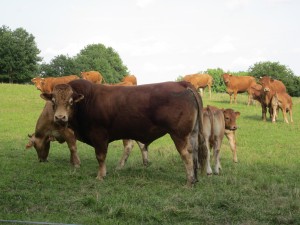
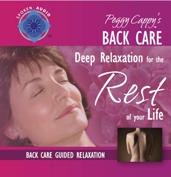 What I am sure about is increased pain and then the magical release from it. Here is the unexplainable magic. I have mentioned it to you several times in the past. It is a 20 minute meditation tape by Peggy Cappy about
What I am sure about is increased pain and then the magical release from it. Here is the unexplainable magic. I have mentioned it to you several times in the past. It is a 20 minute meditation tape by Peggy Cappy about 